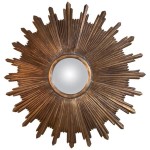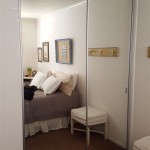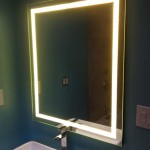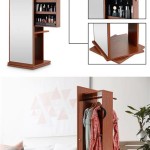Floor To Ceiling Mirrors: Maximizing Space and Enhancing Aesthetics
Floor to ceiling mirrors represent a significant design element in modern interior architecture. They transcend the simple function of reflection, acting as a powerful tool to manipulate perception, enhance lighting, and create a sense of spaciousness. The strategic placement of a floor to ceiling mirror can transform a small, cramped room into an airy, visually expansive environment. This article explores the various benefits, applications, and considerations associated with integrating floor to ceiling mirrors into residential and commercial spaces.
Amplifying Space and Light
The primary advantage of a floor to ceiling mirror is its ability to create the illusion of a larger space. By reflecting the existing room, it effectively doubles the perceived size, making it particularly valuable in smaller apartments, narrow hallways, or rooms with low ceilings. This effect is achieved by extending the visual boundaries of the room, blurring the lines between reality and reflection. The mirror captures and reflects the surrounding environment, including furniture, décor, and natural light, effectively extending the room's visual footprint.
Beyond spatial expansion, floor to ceiling mirrors significantly enhance the available light within a room. They act as a powerful reflector, bouncing both natural and artificial light back into the space. This is particularly beneficial in rooms with limited natural light sources, such as basement apartments or interior rooms. By amplifying the existing light, the mirror creates a brighter, more inviting atmosphere, reducing the need for excessive artificial lighting and potentially leading to energy savings. The light distribution is also more even, minimizing harsh shadows and creating a more pleasant and comfortable environment.
The placement of the mirror in relation to light sources is critical for maximizing its effectiveness. Positioning the mirror opposite a window or near a significant light fixture will amplify the light's impact throughout the room. Careful consideration of the reflected view is also essential; reflecting a cluttered area will simply double the visual clutter, negating the benefits of the mirror. Instead, reflecting a visually appealing area, such as a plant or a decorative wall, can enhance the room's overall aesthetic.
Aesthetic Versatility and Design Integration
Floor to ceiling mirrors are remarkably versatile in terms of design integration. They can be incorporated into a wide range of architectural styles, from minimalist modern to classic traditional. The mirror itself can be customized in various ways to complement the existing décor, including the size, shape, and frame style. Frameless mirrors offer a sleek, contemporary look, blending seamlessly into the surrounding walls. Framed mirrors, on the other hand, can add a touch of elegance or personality, depending on the frame material and design.
The mirror can be used as a focal point within a room, drawing the eye and creating a sense of visual interest. In a living room, a large floor to ceiling mirror can serve as a dramatic backdrop for a seating area, reflecting the furniture and creating a sense of depth. In a bedroom, it can be strategically placed to reflect natural light and create a calming and serene atmosphere. In a hallway, it can visually widen the space and make it feel less claustrophobic.
Beyond their functional benefits, floor to ceiling mirrors can also be used as decorative elements. They can be used to highlight architectural features, such as a fireplace or a unique wall texture. They can also be used to create interesting reflections and visual effects, adding a touch of drama and sophistication to the room. The possibilities are limited only by imagination and the overall design aesthetic of the space.
The reflectivity of the mirror itself can be adjusted depending on the desired effect. Some mirrors have a higher reflectivity, creating a brighter and more dramatic reflection. Others have a lower reflectivity, creating a more subtle and diffused effect. The choice of reflectivity will depend on the specific lighting conditions and the overall aesthetic goals of the project.
Practical Considerations and Installation
While floor to ceiling mirrors offer numerous benefits, there are also several practical considerations to keep in mind. Safety is paramount, especially in households with children or pets. The mirror should be securely mounted to the wall to prevent it from falling or breaking. Tempered glass is recommended for its increased strength and shatter-resistant properties. If the mirror does break, it will shatter into small, relatively harmless pieces, reducing the risk of injury.
Installation of a floor to ceiling mirror is typically best left to professionals. Due to the size and weight of the mirror, specialized tools and techniques are required to ensure a safe and secure installation. A professional installer will have the expertise and experience to properly assess the wall structure, select the appropriate mounting hardware, and ensure that the mirror is perfectly level and aligned.
Maintenance is another important consideration. Floor to ceiling mirrors require regular cleaning to maintain their reflective properties and prevent streaks and smudges. A microfiber cloth and a mild glass cleaner are typically sufficient for routine cleaning. Avoid using abrasive cleaners or harsh chemicals, as these can damage the surface of the mirror. Regular cleaning will help to keep the mirror looking its best and ensure that it continues to enhance the space.
The cost of a floor to ceiling mirror can vary depending on the size, shape, frame style, and installation costs. Frameless mirrors are generally less expensive than framed mirrors. Custom-made mirrors will typically cost more than standard sizes. It is important to obtain multiple quotes from different suppliers and installers to ensure that the price is competitive and that the quality of the materials and workmanship is high. A well-installed and properly maintained floor to ceiling mirror can significantly enhance the value and appeal of a property, making it a worthwhile investment.
In summary, floor to ceiling mirrors are a powerful design tool that can transform the look and feel of a space. By amplifying light, creating the illusion of spaciousness, and adding a touch of elegance, they can enhance the aesthetics and functionality of any room. Careful planning and professional installation are essential to ensure that the mirror is safely and effectively integrated into the overall design. With proper care and maintenance, a floor to ceiling mirror can provide years of enjoyment and value.

A Grand Entrance With Floor To Ceiling Mirrors Foyer Design Mirror Wall

Ceiling To Floor Hallway Wall Mirrors Osborn Glass

Floor To Ceiling Mirror White Walls Modern Lamp Rug Scandinavian Hall Of Terrific Pequenos Corredores Espaços Decoração De Casa

A Flabbergasting Home Decor That Brims With Floor To Ceiling Mirrors

Enhance Your Home Decor With Mirrors

Floor To Ceiling Mirror Design Ideas

Floor To Ceiling Mirrors Transitional Living Room John Jacob Interiors

Mod The Sims Wcif A Wall Mirror Floor To Ceiling

Nordic Light Luxury Full Floor To Ceiling Mirror Home Simple Bedroom Girl Fitting Dressing Clothing Wrought Iron China Large Wall Length Stand Made In Com

What Can Be Done With The Floor To Ceiling Mirrored Wall








